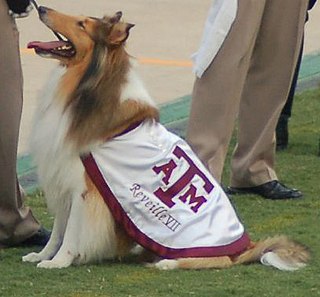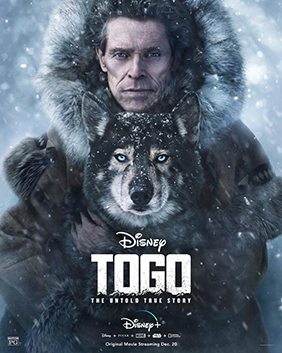
The Siberian Husky is a medium-sized working sled dog breed. The breed belongs to the Spitz genetic family. It is recognizable by its thickly furred double coat, erect triangular ears, and distinctive markings, and is smaller than the similar-looking Alaskan Malamute.

Northeastern University is a private research university with its main campus in Boston, Massachusetts. Established in 1898, it was founded by the Boston Young Men's Christian Association as an all-male institute before being incorporated as Northeastern College in 1916, gaining university status in 1922. With more than 36,000 students, Northeastern is one of the largest universities in Massachusetts by enrollment.

Balto was an Alaskan husky and sled dog belonging to musher and breeder Leonhard Seppala. He achieved fame when he led a team of sled dogs driven by Gunnar Kaasen on the final leg of the 1925 serum run to Nome, in which diphtheria antitoxin was transported from Anchorage, Alaska, to Nenana, Alaska, by train and then to Nome by dog sled to combat an outbreak of the disease.

The Washington Huskies are the intercollegiate athletic teams that represent the University of Washington, located in Seattle. The school competes at the National Collegiate Athletic Association (NCAA) Division I level as a member of the Pac-12 Conference.

Uga is the official live mascot of the University of Georgia Bulldogs. Since Uga I's introduction in 1956, every Uga has been owned by the Sonny Seiler family of Savannah, Georgia.

Reveille is the official mascot of Texas A&M University. Students adopted the first Reveille, a mixed-breed dog, in 1931. The cadets raised $100 during World War II to make Reveille a general, as part of a fundraiser for the K-9 Corps. Reveille is the highest-ranking member of the Texas A&M Corps of Cadets.

Togo was the lead sled dog of musher Leonhard Seppala and his dog sled team in the 1925 serum run to Nome across central and northern Alaska. Despite covering a far greater distance than any other lead dogs on the run, over some of the most dangerous parts of the trail, his role was left out of contemporary news of the event at the time, in favor of the lead dog for the last leg of the relay, Balto, whom Seppala also owned and had bred.
Handsome Dan is a bulldog who serves as the mascot of Yale University's sports teams. In addition to a person wearing a costume, the position is filled by an actual bulldog, the honor being transferred to another upon death or retirement.

Leonhard "Sepp" Seppala was a Norwegian-Finnish-American sled dog breeder, trainer and musher who with his dogs played a pivotal role in the 1925 serum run to Nome, and participated in the 1932 Winter Olympics. Seppala introduced the work dogs used by Native Siberians at the time to the American public; the breed came to be known as the Siberian Husky in the English-speaking world. The Leonhard Seppala Humanitarian Award, which honors excellence in sled dog care, is named in honour of him.

Tusk is the name of the official live mascot for the University of Arkansas Razorbacks. The current live mascot is Tusk VI. All Tusks so far have been male and from the same lineage.

Smokey is the mascot of the University of Tennessee sports teams. These teams, named "The Volunteers" and nicknamed "the Vols", use both a live and a costumed version of Smokey.

The UMBC Retrievers are the athletic teams that represent the University of Maryland, Baltimore County, located in Catonsville, Maryland, in intercollegiate athletics as a member of the Division I level of the National Collegiate Athletic Association (NCAA), primarily competing in the America East Conference since the 2003–04 academic year. The Retrievers previously competed in the Northeast Conference (NEC) from 1998–99 to 2002–03; and in the Big South Conference from 1992–93 to 1997–98; while they also competed in the Mason–Dixon Conference at the NCAA Division II ranks: the first variation of it from 1972–73 to 1977–78; and the second variation from 1983–84 to 1987–88.

Peruna is the official mascot and fight song of the Southern Methodist University (SMU) Mustangs, named after Peruna, a popular patent medicine. The name "Peruna" is given to each successive live mascot. The mascot debuted in 1932, and since then a black Shetland pony, Peruna, has been present at every SMU home football game except for one. The costumed mascot is also referred to as "Peruna." Peruna was selected the #10 Best College Mascot by America's Best and Top Ten in 2009.

Jack the Bulldog is the official mascot of the Georgetown University Hoyas athletic teams. The school has employed at least nine live Bulldogs as mascots, and counts seven named Jack since 1962, when the name first came into use, including three who are still living. The current incarnation of Jack, who will be taking over from his predecessor during the spring 2024 semester, is an English Bulldog born in 2023 whose full name is Serchell's John P. Carroll. Recent bulldogs have come from the Georgetown alumni family of Janice and Marcus Hochstetler.

Jonathan the Husky is the mascot of the University of Connecticut. All of UConn's huskies are named Jonathan in honor of Jonathan Trumbull, the last colonial and first state Governor of Connecticut. Traditionally, there are two Jonathan mascots: one is a student in a costume which resembles the university's Athletics logo, and the other is a live husky canine.

Harry the Husky is a body-suit mascot for the University of Washington, one of two mascots the university's athletic program currently uses. Hendrix the Husky is Harry's brother that lives at UW Tacoma.

Bully is the official mascot of the Mississippi State University Bulldogs in Starkville, Mississippi, and the name is given to both the costumed mascot and the live bulldog that appears at State games. The live mascot Bully is an American Kennel Club registered English Bulldog, and each dog is given the inherited title of "Bully". The name "Bully" is traditionally considered a title and not the official name of the specific dog that holds it.

Watchman, a Staffordshire Bull Terrier, is a military mascot of the now disbanded Staffordshire Regiment. He continues his duties as part of the Staffordshire Regimental Association. The same name has been given to a succession of Staffordshire Bull Terriers – as of 2018, six.

Togo is a 2019 American historical adventure film directed by Ericson Core and produced by Walt Disney Pictures. The film centers on Leonhard Seppala and his titular sled dog in the 1925 serum run to Nome to transport diphtheria antitoxin serum through harsh conditions during an epidemic of diphtheria. The film stars Willem Dafoe, Julianne Nicholson, Christopher Heyerdahl, Michael Gaston, Michael McElhatton, Jamie McShane, Michael Greyeyes, Thorbjørn Harr, Shaun Benson, and Nikolai Nikolaeff. It was released on Disney+ on December 20, 2019. The movie received generally positive reviews from critics.

















